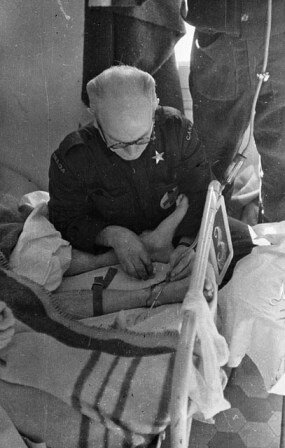Dr. Norman Bethune

Dr. Norman Bethune was a Canadian who volunteered his medical services on behalf of the Republic. Dr. Bethune played an important role in the advancement of battlefield medicine, by his avocation of blood transfusions in the field. Prior to this transfusions would only be performed in a hospital setting and many wounded soldiers bled to death before arriving. Dr. Bethune's mobile medical units contained the necessary equipment and stored blood to allow soldiers to receive blood transfusions at the front, giving them a chance to make it to the hospital for treatment. Dr Bethune died at the age of 49 in 1939 while serving in China with the Communist Chinese forces.
The image of Dr. Bethune is in the public domain and is held by the Library and Archives of Canada.
Foreign Aid to the Nationalists
Foreign aid was crucial to the Nationalist war effort in two ways. At the beginning of the uprising the Nationalists failed to capture the industrial centers of Spain and the finances of the Spanish state. Faced with a protracted war these failures put them in a potentially difficult position, since they had neither the currency reserves to buy weapons and fuel, or the industrial capacity to manufacture war material. However, aid in terms of equipment was extremely quick in coming. The head of oil company Texaco ordered oil tankers headed for Spain at the start of the uprising to make for Nationalist controlled ports, and Texaco would continue to supply oil to the Nationalists on credit for the duration of the war.
Similarly, both the German and Italian governments responded quickly to Nationalist pleas for aircraft. Indeed the arrival of aircraft form both countries in Spanish Morocco in July 1936 allowed the Nationalists to ferry units of the veteran Army of Africa to mainland Spain. These units would score some of the most decisive victories of the early war and see the Nationalists reach the gates of Madrid.
In addition to supplying material aid, the two fascist powers, Germany and Italy, supplied troops to fight on behalf of the Nationalists. The Italians send the largest number and they saw action in many of the major battles of the war. The German contribution, the Condor Legion was smaller but highly effective. It consisted of aircraft, both bombers and fighters, as well as a tank battalion and anti-air units. The Condor Legion provided strong support to the Nationalists and was invaluable in many operations. In a foreshadowing of World War II, the Condor Legion was responsible for the destruction of Guernica through aerial bombardment, an act that caused shock around the world and prompted Nationalist denials of their involvement.
The Battle of Teruel
The battle for Teruel began on December 15th 1937 when the Republicans launched an offensive aimed at capturing this Aragónese provincial capital. The offensive was partially aimed at distracting the Nationalists who had recently concluded the was in the North, so they would not be able to mount another offensive on Madrid. The fighting for Teruel would all take place in cold, snowy conditions, sometimes even blizzard conditions. Frostbite would cause many casualties during the campaign and the weather would hamper troop movements for both sides.
The initial Republican attack force was around 100,000 men strong and by December 25th they had entered Teruel and engaged in street fighting with the Nationalist defenders. Franco meanwhile pursued his usual strategy of immediately moving troops to counterattack any Republican offensive. By December 24th he was ready to begin his counteroffensive and by January 1st 1938, Nationalist artillery was able to begin bombarding the city. Despite the nearness of their would be rescuers the remains of the Nationalist garrison in Teruel were forced to surrender on January 8th.
By january 19th increasing Nationalist pressure forced the Republicans to deploy the International Brigades to Teruel. It was not enough to stem the Nationalist counteroffensive and by February 7th the Republic had lost around 500 square miles of territory. The Nationalists were able to encircle the town of Teruel, forcing the Republicans holding it into hasty retreat. Nationalists entered the town on February 20th and quickly gained control of the city. The result was a disaster for the Republic, with an initial morale boosting capture of a provincial capital quickly countered by its lost, along with many men and much equipment. While it is thought that the Nationalists may have suffered 30,000 dead and wounded in the fighting (and a possible 17,000 ill), the Republicans are believed to have suffered in much greater numbers. At least 21,000 Republicans had been taken prisoner by the time the fighting finished.